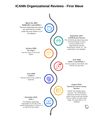ICANN Historical Timeline: Difference between revisions
No edit summary |
|||
| Line 56: | Line 56: | ||
* June 1997, the Clinton administration commits to the privatization of DNS management. | * June 1997, the Clinton administration commits to the privatization of DNS management. | ||
====Documents==== | ====Documents==== | ||
* [ | * [https://clintonwhitehouse4.archives.gov/WH/New/Commerce/Framework for Global Electronic Commerce] | ||
==1998: Birth of ICANN== | ==1998: Birth of ICANN== | ||
Revision as of 17:34, 22 November 2021
ICANN's history and the history of the Internet are interlinked, and the mission of ICANN was carried out prior to its formation by volunteers, governmental actors, and academic institutions. The following is an attempt to categorize the history (and prehistory) of ICANN and the Domain Name System into eras. Some eras are defined by technical and technological advances, while others are defined by policy initiatives, structural or operational changes to ICANN org, or a broader thematic push. For instance, the present era involves the globalization of access to and use of the Internet; despite ICANN being committed to the global Internet community from its inception, several trends are converging to make the present moment a fight for global and universal access and acceptance: the BRIC countries will represent the vast majority of Internet growth in the coming decade; Internationalized Domain Names are growing in prominence and the effort to ensure universal acceptance of alternate language scripts is as well; efforts to nationalize the DNS by China and Russia are forcing a broader conversation about the value and impact of a global Internet; and ICANN itself is aggressively seeking to improve its presence in and outreach to under-represented parts of the world.
ICANN has grown and changed significantly over the years. Many people have made contributions throughout their lives to shaping how the Internet and ICANN work. The following is an abbreviated look at notable events, developments, documents, and activity the birth of the Internet and the development of ICANN. It should not be taken as a canonical resource regarding ICANN's evolution. Technological and policy initiatives overlap. The boundaries for each era are necessarily fuzzy. Although the effort is to identify themes within the events and history of a given era, there is no guarantee that we have it "right," or that there is a "perfectly correct" representation of a given timeframe.
1968-1976: The Birth of the Internet[edit | edit source]
ARPANET[edit | edit source]
-
NLS System at Stanford, 1968[1]
-
The "Mother of All Demos," 1968[2]
-
Interface Message Processor, 1969[4]
-
Queen Elizabeth II sends an email, 1976[5]
1972[edit | edit source]
Events[edit | edit source]
- UCLA grad student Jon Postel proposes that a "numbers czar" be appointed to keep a record of addresses on the ARPANET and guard against address collisions. The research community agrees and elects Postel to the position of internet numbers coordinator (eventually to become known as the Internet Assigned Numbers Authority).[6] Ultimately, the ARPANET was a product of DARPA, the Defense Advanced Research Projects Agency. MIT, the University of Southern California, UCLA, and the Stanford Research Institute, under contract with DARPA, were all instrumental in the development of technologies that are still used today in the modern Internet.[7] Jon Postel, Vint Cerf, Steve Crocker, and other Internet pioneers were first connected with ARPANET projects and innovations.
1983-1988: Birth of the DNS[edit | edit source]
1983[edit | edit source]
Events[edit | edit source]
- Postel officially establishes IANA
1986[edit | edit source]
Events[edit | edit source]
1987[edit | edit source]
Events[edit | edit source]
- Over 20,000 servers online hosting websites
1988-1995: Legitimization[edit | edit source]
1988[edit | edit source]
Documents & RFCs[edit | edit source]
- RFC 1083 - Internet Activities Board Official Protocol Standards (first mention of the Internet Assigned Numbers Authority (IANA) in the RFC Index)[8]
1992[edit | edit source]
- Internet goes commercial/ gains a public/ officially becomes marketplace
Documents & RFCs[edit | edit source]
- RFC 1358 - Original Charter of the Internet Architecture Board (the Internet Activities Board gets a new name and charter document)[9]
- RFC 1386 - The .US Domain (Jon Postel explains structure and use of the .US ccTLD and second-level domains for states)[10]
1993[edit | edit source]
Events[edit | edit source]
In January 1993, Network Solutions enters into a five-year contract with the NSF to provide domain name registration and network number assignment services.
Documents & RFCs[edit | edit source]
- RFC 1436 - Internet Gopher Protocol[11]
- RFC 1527 - What Should We Plan Given the Dilemma of the Network? (Gordon Cook presents his thoughts and proposals, developed during his time with the Congressional Office of Technology Assessment, on the possible regulatory and policy needs of the National Research and Education Network and the "American" internet, as they become a noncommercial part of the global internet)[12]
1994[edit | edit source]
Events[edit | edit source]
- Postel publishes what will become a canonical resource for the management of (and debates regarding) the domain name system.
Documents & RFCs[edit | edit source]
1996-1997: Internet Governance in Broad Strokes[edit | edit source]
1997[edit | edit source]
Events[edit | edit source]
- In May 1997, the ISOC and IANA form the International Ad Hoc Committee (IAHC) concerning the development of a new governance model for TLDs following the expansion and commercialization of the Internet.
- June 1997, the Clinton administration commits to the privatization of DNS management.
Documents[edit | edit source]
1998: Birth of ICANN[edit | edit source]
Events[edit | edit source]
- In February 1998, the National Telecommunications Information Administration (NTIA) creates a Proposal to Improve the Technical Management of Internet Names and Addresses.
- In September 1998, ICANN files its Articles of Incorporation with the California Secretary of State.
- In October 1998, ICANN’s first board meeting is held in New York, at which Esther Dyson is named Chairman and Mike Roberts is designated President of ICANN.
- In November 1998, a Memorandum of Understanding between the United States Department of Commerce and ICANN is signed.[13] Contemporaneously with the signing of the MoU, ICANN amends its Articles of Incorporation to include a broader statement of public benefit that conforms to the expectations of the MoU.
- The U.S. Department of Commerce releases the “Management of Internet Names and Addresses” outlining the objectives of ensuring DNS stability, maintaining competition, keeping Internet Governance in the private sector, relying on bottom-up coordination, and encouraging diverse and global representation.
- In December 1998, the University of Southern California (USC) and ICANN enter into the IANA functions transition agreement.
Documents[edit | edit source]
- The Green Paper
- The White Paper
1999-2002: ICANN's Ad Hoc Era[edit | edit source]
Privatization Marilyn Cade DNSO exists PSO, ASO are reserved
2002 ICANN Reform (toddler)[edit | edit source]
2003 2004
2005-2006 (youth) fulfillment of Differentiation/Expansion of ICANN bodies[edit | edit source]
2007 - 2009 (youth) Infinite reviewing cycles begin[edit | edit source]
-
First Organizational Review Timeline
-
Rough Timeline of ICANN Review Overlap
The ICANN Bylaws call for two different types of review - organizational reviews (Article 4.4) and specific reviews (Article 4.6). Article 4.4 reviews were born from the 2002 Evolution and Reform Process, and require periodic review of ICANN's supporting organizations and advisory committees. Article 4.6 reviews originated in the Affirmation of Commitments, and the first round of "specific" reviews occurred before these reviews were enshrined in the bylaws. The amendment to the bylaws came about as a result of the IANA Functions Stewardship Transition, when it was recommended that the bylaws be revised to incorporate ICANN's obligations under the Affirmation of Commitments.
As the organizational reviews began, ICANN was in the process of entering into the Affirmation of Commitments with the United States Department of Commerce. As a result, the first specific reviews were launched in 2010, while most of the organizational reviews were still in progress or only recently completed. Many community members since that date have commented on what seems to be a relentless cycle of reviews of one aspect of ICANN or another (or many others at the same time).
ATRT 3 addressed this issue head-on, suggesting that organizational reviews be replaced by "continuous improvement programs," the results of which could feed into a single, "holistic" review of the organization and its constituent parts, to be performed on a periodic basis. In addition, the ATRT 3 team recommended suspending the next cycle of specific reviews until the completion of the next Accountability and Transparency Review. These recommendations were met with varying levels of enthusiasm. The ICANN Board approved the recommendations in the fall of 2020, with caveats. On the specific review side, the board noted that community approval would be required to amend the bylaws around specific reviews. In the organizational review reforms, the board agreed to implement pilot projects testing both the "holistic" review model and a continuous improvement model.
2009-2012 (tween) defining accountability and transparency at ICANN[edit | edit source]
2012-___ “Scale the Root” (adolescent) Big 2012 round[edit | edit source]
2014-2017-ish IANA Transition - (young adult)[edit | edit source]
2017 - present Universality - (adult) IANA Transition “complete” to present day[edit | edit source]
References[edit | edit source]
- ↑ DARPA.mil - NLS
- ↑ DARPA.mil - the MOAD
- ↑ DARPA.mil - Paving the Way to the Modern Internet
- ↑ DARPA.mil - The ARPANET
- ↑ Malvern Radar and Technology History Society - HM Queen Elizabeth II sends Email
- ↑ Internet Society - IANA Timeline
- ↑ LiveScience.com - ARPANET to the World Wide Web, published June 2017
- ↑ RFC 1083 - IAB Official Protocol Standards, December 1988
- ↑ RFC 1358 - Charter of the Internet Architecture Board (IAB), August 1992
- ↑ RFC 1386 - The .US Domain, December 1992
- ↑ RFC 1436 - Internet Gopher Protocol, March 1993
- ↑ RFC 1527 - What Should We Plan Given the Dilemma of the Network?, September 1993
- ↑ ICANN.org Archive - Memorandum of Understanding, November 25, 1998

![NLS System at Stanford, 1968[1]](/images/thumb/e/e1/NLS_-_Stanford_1968.jpg/120px-NLS_-_Stanford_1968.jpg)
![The "Mother of All Demos," 1968[2]](/images/thumb/e/e8/1968b_MOAD.jpg/120px-1968b_MOAD.jpg)
![Concept drawing of ARPANET, 1969[3]](/images/thumb/4/4a/1969_ARPANET_290x230.png/120px-1969_ARPANET_290x230.png)
![Interface Message Processor, 1969[4]](/images/thumb/a/af/1969a_ARPANET_full.jpg/58px-1969a_ARPANET_full.jpg)
![Queen Elizabeth II sends an email, 1976[5]](/images/thumb/8/84/Queen-Elizabeth-II-sending-her-first-e-mail.jpg/120px-Queen-Elizabeth-II-sending-her-first-e-mail.jpg)

